2013 CITROEN C4 DAG belt
[x] Cancel search: beltPage 136 of 340
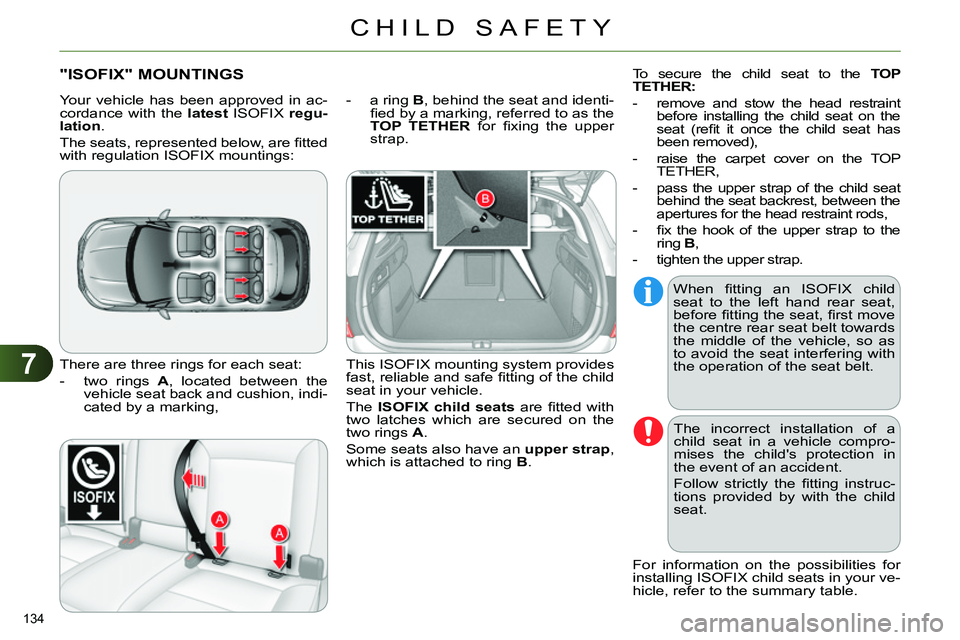
7
CHILD SAFETY
134
"ISOFIX" MOUNTINGS
There are three rings for each seat:
- two rings A
, located between the
vehicle seat back and cushion, indi-
cated by a marking,
- a ring B
, behind the seat and identi-
fi ed by a marking, referred to as the
TOP TETHER
for fi xing the upper
strap.
This ISOFIX mounting system provides
fast, reliable and safe fi tting of the child
seat in your vehicle.
The ISOFIX child seats
are fi tted with
two latches which are secured on the
two rings A
.
Some seats also have an upper strap
,
which is attached to ring B
.
The incorrect installation of a
child seat in a vehicle compro-
mises the child's protection in
the event of an accident.
Follow strictly the fi tting instruc-
tions provided by with the child
seat.
For information on the possibilities for
installing ISOFIX child seats in your ve-
hicle, refer to the summary table.
When fi tting an ISOFIX child
seat to the left hand rear seat,
before fi tting the seat, fi rst move
the centre rear seat belt towards
the middle of the vehicle, so as
to avoid the seat interfering with
the operation of the seat belt.
Your vehicle has been approved in ac-
cordance with the latest
ISOFIX regu-
lation
.
The seats, represented below, are fi tted
with regulation ISOFIX mountings: To secure the child seat to the TOP
TETHER:
- remove and stow the head restraint
before installing the child seat on the
seat (refi t it once the child seat has
been removed),
- raise the carpet cover on the TOP
TETHER,
- pass the upper strap of the child seat
behind the seat backrest, between the
apertures for the head restraint rods,
- fi x the hook of the upper strap to the
ring B
,
- tighten the upper strap.
Page 137 of 340
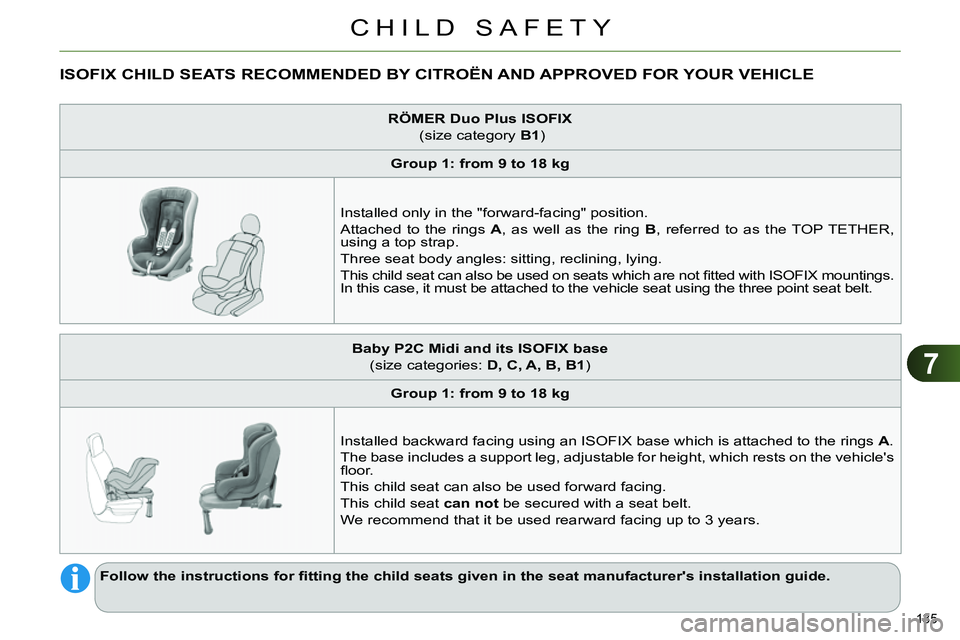
7
CHILD SAFETY
135
ISOFIX CHILD SEATS RECOMMENDED BY CITROËN AND APPROVED FOR YOUR VEHICLE
RÖMER
Duo Plus ISOFIX
(size category B1
)
Group 1: from 9 to 18 kg
Installed only in the "forward-facing" position.
Attached to the rings A
, as well as the ring B
, referred to as the TOP TETHER,
using a top strap.
Three seat body angles: sitting, reclining, lying.
This child seat can also be used on seats which are not fi tted with ISOFIX mountings.
In this case, it must be attached to the vehicle seat using the three point seat belt.
Follow the instructions for fi tting the child seats given in the seat manufacturer's installation guide.
Baby P2C Midi and its ISOFIX base
(size categories: D, C, A, B, B1
)
Group 1: from 9 to 18 kg
Installed backward facing using an ISOFIX base which is attached to the rings A
.
The base includes a support leg, adjustable for height, which rests on the vehicle's
fl oor.
This child seat can also be used forward facing.
This child seat can
not
be secured with a seat belt.
We recommend that it be used rearward facing up to 3 years.
Page 139 of 340
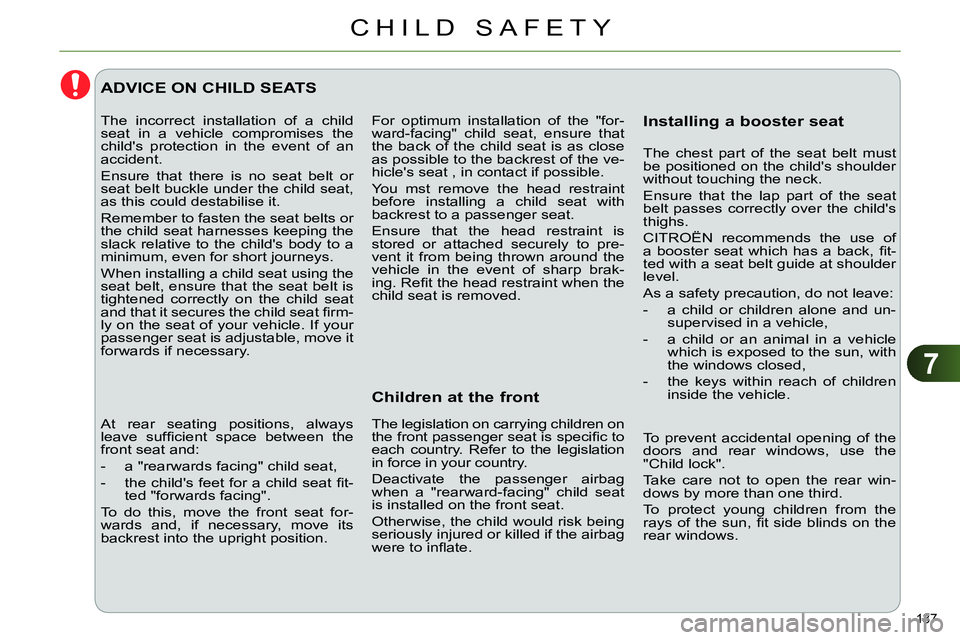
7
CHILD SAFETY
137
For optimum installation of the "for-
ward-facing" child seat, ensure that
the back of the child seat is as close
as possible to the backrest of the ve-
hicle's seat , in contact if possible.
You mst remove the head restraint
before installing a child seat with
backrest to a passenger seat.
Ensure that the head restraint is
stored or attached securely to pre-
vent it from being thrown around the
vehicle in the event of sharp brak-
ing. Refi t the head restraint when the
child seat is removed.
ADVICE ON CHILD SEATS
Installing a booster seat
Children at the front
The incorrect installation of a child
seat in a vehicle compromises the
child's protection in the event of an
accident.
Ensure that there is no seat belt or
seat belt buckle under the child seat,
as this could destabilise it.
Remember to fasten the seat belts or
the child seat harnesses keeping the
slack relative to the child's body to a
minimum, even for short journeys.
When installing a child seat using the
seat belt, ensure that the seat belt is
tightened correctly on the child seat
and that it secures the child seat fi rm-
ly on the seat of your vehicle. If your
passenger seat is adjustable, move it
forwards if necessary.
The legislation on carrying children on
the front passenger seat is specifi c to
each country. Refer to the legislation
in force in your country.
Deactivate the passenger airbag
when a "rearward-facing" child seat
is installed on the front seat.
Otherwise, the child would risk being
seriously injured or killed if the airbag
were to infl ate.
The chest part of the seat belt must
be positioned on the child's shoulder
without touching the neck.
Ensure that the lap part of the seat
belt passes correctly over the child's
thighs.
CITROËN recommends the use of
a booster seat which has a back, fi t-
ted with a seat belt guide at shoulder
level.
As a safety precaution, do not leave:
- a child or children alone and un-
supervised in a vehicle,
- a child or an animal in a vehicle
which is exposed to the sun, with
the windows closed,
- the keys within reach of children
inside the vehicle.
At rear seating positions, always
leave suffi cient space between the
front seat and:
- a "rearwards facing" child seat,
- the child's feet for a child seat fi t-
ted "forwards facing".
To do this, move the front seat for-
wards and, if necessary, move its
backrest into the upright position. To prevent accidental opening of the
doors and rear windows, use the
"Child lock".
Take care not to open the rear win-
dows by more than one third.
To protect young children from the
rays of the sun, fi t side blinds on the
rear windows.
Page 145 of 340

8
SAFETY
143
Seat belt not fastened / unfastened
warning lamp in the instrument panel
When the ignition is switched on,
this warning lamp comes on in
the instrument panel if the driver
and/or the front passenger has
not fastened their seat belt.
1.
Driver's seat belt not fastened / un-
fastened warning lamp.
2.
Front passenger's seat belt not fas-
tened / unfastened warning lamp.
Seat belt not fastened / unfastened
warning lamps display
To lower the attachment point,
squeeze the control A
and slide it
downwards.
To raise the attachment point, slide
the control A
upwards.
Height adjustment
SEAT BELTS
Front seat belts
The front seat belts are fi tted with a pre-
tensioning and force limiting system.
This system improves safety in the front
seats in the event of a front or side im-
pact. Depending on the severity of the
impact, the pretensioning system in-
stantly tightens the seat belts against
the body of the occupants.
The pretensioning seat belts are active
when the ignition is on.
The force limiter reduces the pressure
of the seat belt on the chest of the oc-
cupant, so improving their protection.
Fastening
Pull the strap, then insert the tongue
in the buckle.
Check that the seat belt is fastened
correctly by pulling the strap.
Unfastening
Press the red button on the buckle.
Guide the seat belt as it reels in.
The corresponding warning lamp 1
or
2
comes on in red on the seat belt and
passenger's front airbag warning lamps
display, accompanied by an audible
signal and a message in the screen, if
the seat belt is not fastened or is un-
fastened.
From approximately 12 mph (20 km/h)
this warning lamp fl ashes for two min-
utes accompanied by an audible signal
of increasing volume. Once these two
minutes have elapsed, this warning lamp
remains on until the driver and/or the front
passenger fastens their seat belt.
Page 146 of 340

8
SAFETY
144
Rear seat belts
The rear seats are each fi tted with a
three-point seat belt, with force limiter
and, for the outer seats, an effort limiter.
Fastening
Pull the strap, then insert the tongue
in the buckle.
Check that the seat belt is fastened
correctly by pulling the strap.
Unfastening
Press the red button on the buckle.
Guide the seat belt as it reels in.
On the outer seat belts, raise the
bar to the top of the backrest to
prevent the tongue from knocking
against the side trim.
This warning lamp comes on in
the instrument panel when one
or more rear passengers unfas-
ten their seat belt.
Seat belt unfastened warning lamp
in the instrument panel
3.
Right hand rear seat belt warning
lamp.
4.
Centre rear seat belt warning lamp.
5.
Left hand rear seat belt warning lamp.
Seat belt unfastened warning lamps
display
When the ignition is switched on, with
the engine running or when the ve-
hicle is moving at less than 12 mph
(20 km/h), the corresponding warning
lamps 3
, 4
and 5
come on in red for ap-
proximately 30 seconds, if the seat belt
is not fastened.
When the vehicle is moving at more
than 12 mph (20 km/h), the correspond-
ing warning lamps 3
, 4
and 5
come on
in red, accompanied by an audible sig-
nal and a message in the screen, if a
rear passenger has unfastened their
seat belt.
From approximately 12 mph (20 km/h),
this warning lamp fl ashes for two min-
utes accompanied by an audible signal
of increasing volume. Once these two
minutes have elapsed, this warning
lamp remains on until the one or more
rear passengers fasten their seat belt.
Page 147 of 340
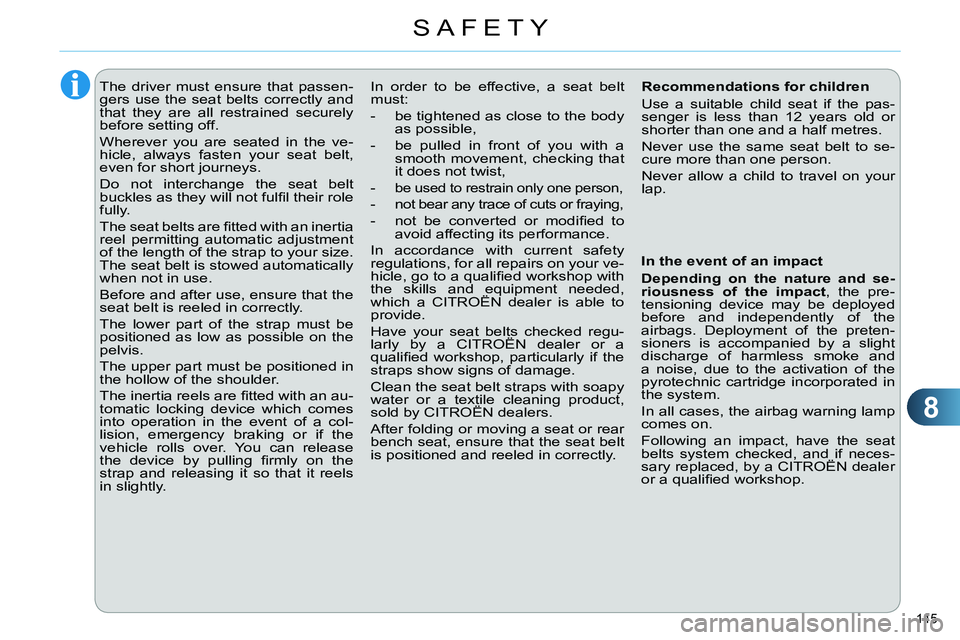
8
SAFETY
145
The driver must ensure that passen-
gers use the seat belts correctly and
that they are all restrained securely
before setting off.
Wherever you are seated in the ve-
hicle, always fasten your seat belt,
even for short journeys.
Do not interchange the seat belt
buckles as they will not fulfi l their role
fully.
The seat belts are fi tted with an inertia
reel permitting automatic adjustment
of the length of the strap to your size.
The seat belt is stowed automatically
when not in use.
Before and after use, ensure that the
seat belt is reeled in correctly.
The lower part of the strap must be
positioned as low as possible on the
pelvis.
The upper part must be positioned in
the hollow of the shoulder.
The inertia reels are fi tted with an au-
tomatic locking device which comes
into operation in the event of a col-
lision, emergency braking or if the
vehicle rolls over. You can release
the device by pulling fi rmly on the
strap and releasing it so that it reels
in slightly. In order to be effective, a seat belt
must:
- be tightened as close to the body
as possible,
- be pulled in front of you with a
smooth movement, checking that
it does not twist,
-
be used to restrain only one person,
- not bear any trace of cuts or fraying,
- not be converted or modifi ed to
avoid affecting its performance.
In accordance with current safety
regulations, for all repairs on your ve-
hicle, go to a qualifi ed workshop with
the skills and equipment needed,
which a CITROËN dealer is able to
provide.
Have your seat belts checked regu-
larly by a CITROËN dealer or a
qualifi ed workshop, particularly if the
straps show signs of damage.
Clean the seat belt straps with soapy
water or a textile cleaning product,
sold by CITROËN dealers.
After folding or moving a seat or rear
bench seat, ensure that the seat belt
is positioned and reeled in correctly.
Recommendations for children
Use a suitable child seat if the pas-
senger is less than 12 years old or
shorter than one and a half metres.
Never use the same seat belt to se-
cure more than one person.
Never allow a child to travel on your
lap.
In the event of an impact
Depending on the nature and se-
riousness of the impact
, the pre-
tensioning device may be deployed
before and independently of the
airbags. Deployment of the preten-
sioners is accompanied by a slight
discharge of harmless smoke and
a noise, due to the activation of the
pyrotechnic cartridge incorporated in
the system.
In all cases, the airbag warning lamp
comes on.
Following an impact, have the seat
belts system checked, and if neces-
sary replaced, by a CITROËN dealer
or a qualifi ed workshop.
Page 148 of 340
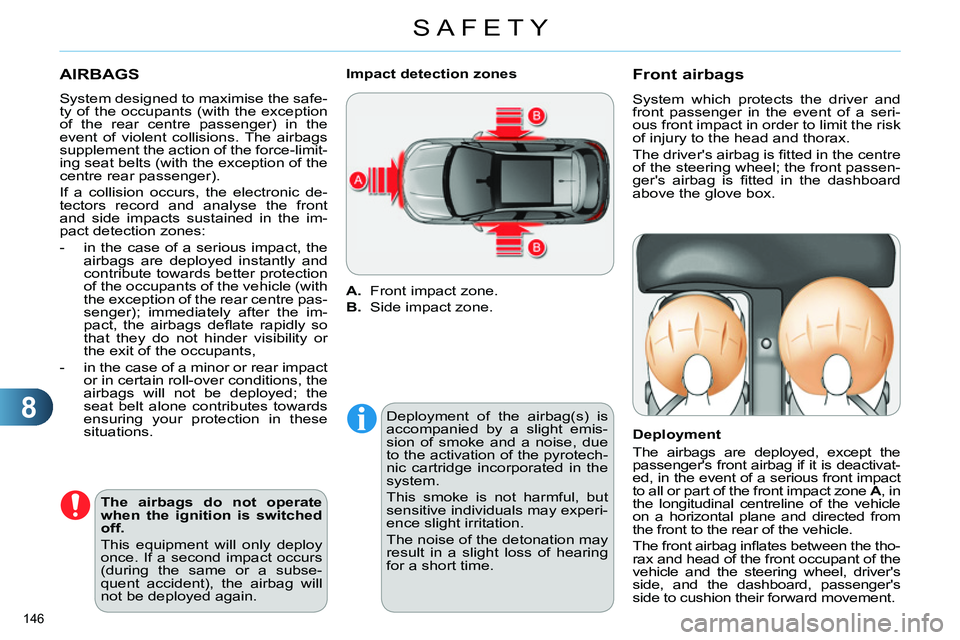
8
SAFETY
146
AIRBAGS
System designed to maximise the safe-
ty of the occupants (with the exception
of the rear centre passenger) in the
event of violent collisions. The airbags
supplement the action of the force-limit-
ing seat belts (with the exception of the
centre rear passenger).
If a collision occurs, the electronic de-
tectors record and analyse the front
and side impacts sustained in the im-
pact detection zones:
- in the case of a serious impact, the
airbags are deployed instantly and
contribute towards better protection
of the occupants of the vehicle (with
the exception of the rear centre pas-
senger); immediately after the im-
pact, the airbags defl ate rapidly so
that they do not hinder visibility or
the exit of the occupants,
- in the case of a minor or rear impact
or in certain roll-over conditions, the
airbags will not be deployed; the
seat belt alone contributes towards
ensuring your protection in these
situations.
The airbags do not operate
when the ignition is switched
off.
This equipment will only deploy
once. If a second impact occurs
(during the same or a subse-
quent accident), the airbag will
not be deployed again.
A.
Front impact zone.
B.
Side impact zone.
Impact detection zones
Deployment of the airbag(s) is
accompanied by a slight emis-
sion of smoke and a noise, due
to the activation of the pyrotech-
nic cartridge incorporated in the
system.
This smoke is not harmful, but
sensitive individuals may experi-
ence slight irritation.
The noise of the detonation may
result in a slight loss of hearing
for a short time.
Front airbags
System which protects the driver and
front passenger in the event of a seri-
ous front impact in order to limit the risk
of injury to the head and thorax.
The driver's airbag is fi tted in the centre
of the steering wheel; the front passen-
ger's airbag is fi tted in the dashboard
above the glove box.
Deployment
The airbags are deployed, except the
passenger's front airbag if it is deactivat-
ed, in the event of a serious front impact
to all or part of the front impact zone A
, in
the longitudinal centreline of the vehicle
on a horizontal plane and directed from
the front to the rear of the vehicle.
The front airbag infl ates between the tho-
rax and head of the front occupant of the
vehicle and the steering wheel, driver's
side, and the dashboard, passenger's
side to cushion their forward movement.
Page 149 of 340

8
SAFETY
147
Deactivation
Only the passenger's front airbag can
be deactivated:
insert the key in the passenger air-
bag deactivation switch,
turn it to the "OFF"
position,
then, remove the key keeping the
switch in the new position.
According to version, this warn-
ing lamp comes on in the in-
strument panel and/or in the
seat belt and passenger's front
airbag warning lamps display when the
ignition is on and until the airbag is re-
activated. To assure the safety of your
child, the passenger's front air-
bag must be deactivated when
you install a "rear facing" child
seat on the front passenger seat.
Otherwise, the child would risk
being seriously injured or killed if
the airbag were deployed.
Reactivation
When you remove the child seat, turn
the switch to the "ON"
position to re-
activate the airbag and so assure the
safety of your front passenger in the
event of an impact.
With the ignition on, this warn-
ing lamp comes on in the seat
belt and passenger's front air-
bag warning lamps display for
approximately one minute, if the pas-
senger's front airbag is activated.
Operating fault
If this warning lamp comes on
in the instrument panel, con-
tact a CITROËN dealer or a
qualifi ed workshop to have the
system checked. The airbags may no
longer be deployed in the event of a se-
rious impact.